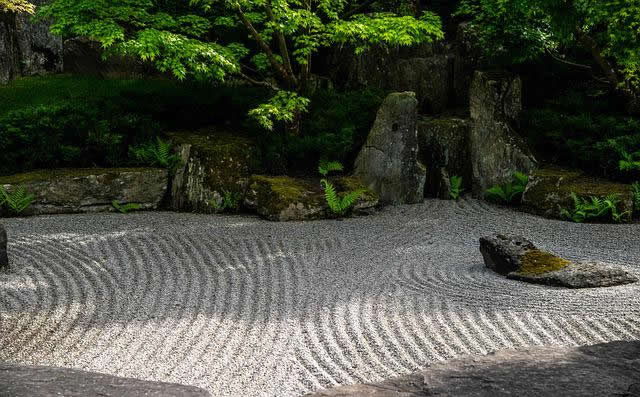今日から「The meaning behind the Japanese Zen garden -「日本の禅庭に込められた意味」を読んでいます。

For most gardeners, stones – along with slugs, blackfly and weeds – are a pest, something to be eradicated.
多くの園芸家にとって、石はナメクジ、クロバエ、雑草と並んで害虫であり、駆除すべきものである。
Yet in Japan, some of the most astonishing gardens consist of nothing but rocks and stones.
しかし日本には、岩と石だけで構成された驚くべき庭園がある。
As 19th-Century writer Lafcadio Hearn wrote:
19世紀の作家、ラフカディオ・ハーンはこう書いている、
“to comprehend the beauty of a Japanese garden, it is necessary to understand the beauty of stones.”
「日本庭園の美しさを理解するためには、石の美しさを理解する必要がある。」
Rock and stones are vital elements in any Japanese garden, and the ultimate expression of the beauty of stones lies in the sekitei,
日本庭園には石がつきものであり、その美しさの極致は石を配置した石庭、
or rock gardens, expanses of raked white gravel, dotted with strategically-placed stones.
白い砂利が敷き詰められ、石が点在するロックガーデンだ。
But there’s more to the gardens than mere beauty.
しかしこの庭園には単なる美しさだけではない魅力がある。
Explorer and art historian Langdon Warner (the inspiration for the Indiana Jones character)
探検家で美術史家のラングドン・ワーナー(インディ・ジョーンズのキャラクターのモデル)は、
observed that Japanese gardens are designed “to express the highest truths of religion and philosophy precisely as other civilisations have made use of the arts of literature and philosophy”.
日本庭園は「他の文明が文学や哲学の芸術を用いたように、宗教や哲学の最高の真理を表現するべく設計されている」と述べている。
確かに庭なのに、植物や花ではなく石が主役というのは、ちょっと不思議かもしれませんね。
田舎住みの私からすると、草取りだけでも大変そう・・・と思ってしまいます(笑)。
非常に不思議で美しい、禅庭の魅力について早速読んでいきましょう。
理由は単純明快!「少ないコストでしっかり楽しく学べるから」。
私自身の経験(高機能でビックリ)をびっしり書いていますので、良かったら読んでみてください。
下のバナーからどうぞ!






